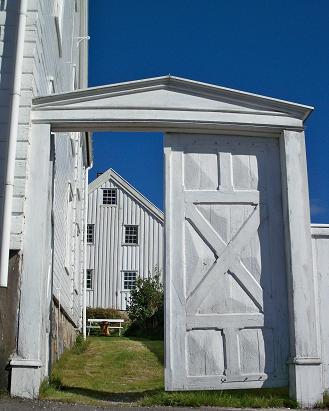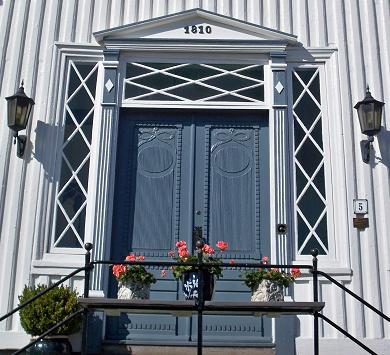Two Lives
14 September 2009
Monday

Flying out of Oslo.
Nearing our departure from Norway, my sister remarked to me that it is as though, when one is traveling, one has two lives: one’s life while traveling and one’s life while at home. She went on to explicitly judge the traveling life to be the better one.

The barren, rocky, glacier-scraped upper elevations.
I find I must reluctantly agree. Reluctantly because to consign the bulk of one’s life to an inferior status, to live optimally only for a few days — at best a few weeks — of each year, is a sad admission. But we ought not to hesitate to proclaim sad truths: the world is full of them.

Aerial view of a fjord.
Life at home, of course, has its satisfactions — satisfactions that we often don’t realize, until home, that we missed. But it is difficult to compare these daily satisfactions to the stimulus of travel. Even when travel is not an adventure per se, it generally involves a much greater diversity and intensity of experience than home life.

Fjord on the left, glacier center, more fjords and the ocean on the right.
There are, of course, all kinds of travel, and not all of them are rewarding. Many travel for business and find the entire experience fatiguing at best. But travel merely to satisfy the desire to travel (or even travel that includes the desire to travel, though it may have other motives as well) is the antithesis of fatiguing: it stimulates the whole of existence that one feels as though one lives a separate existence while traveling.
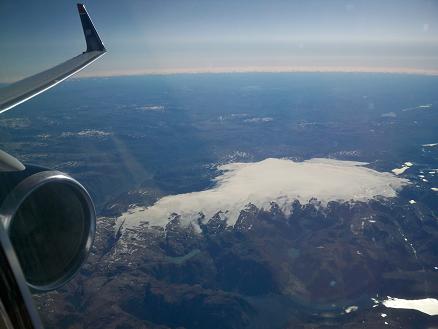
A glacier on Norway's coastal mountains.
Hence the two lives: the traveling life of heightened sensations and stimulation, and the life of our day-to-day routine existence. One could go so far as to characterize these two lives as the exceptional life and the mundane life (or, more schematically, the unexceptional life).
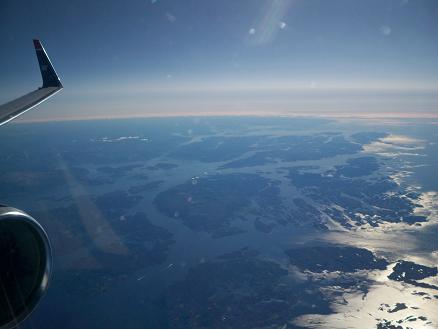
The west coast of Norway where, a few days ago, I stood upon the ground and drove the winding roads.
Think how this distinction cuts across the traditional distinction between the active life and the contemplative life — vita activa and vita contemplativa — that figured in Aristotle’s conception of the good life. The exceptional life of travel is a life of active engagement with the world, but it is also a contemplative life because of the greater intellectual stimulation one enjoys as a result of travel. The mundane life of home and work is also an active life, but when we think of the activity of our working life (unless, that is, one has a wonderful and stimulating job) the contrast with the active life of travel is obvious even if it is not easy to formulate. And mundane life can be the vita contemplativa if one makes the effort — the sort of daily effort that I make to think through things until I arrive an conceptual clarity — but in travel new ideas naturally flow from the kind of active engagement one has with the world.

Cloudscape with sunset over Philadelphia.
A few phone calls from the Philadelphia airport were enough to remind me of my mundane responsibilities and even — again, a sad admission — to dampen my spirits so lately raised by the joy of new sights, new sounds, and new tastes of wonderful dinners in beautiful surroundings. In the coming days I will count on the lingering ex post facto stimulation of travel that derives from cultivating the memory of what one has seen, as well as the pleasant prospect of planning further journeys.

The lights of Chicago from cruising altitude.
. . . . .
. . . . .
From Lillesand to Oslo
13 September 2009
Sunday
Goodbye to Oslo
Goodbye to Norway
One could scarcely ask for a greater departure gift than a fine last day, and the day dawned spectacularly clear and bright and sunny in Lillesand. It was a long day of driving and sightseeing, but I completed my touring of Norway where I began it: with a final evening visit to the Vigeland sculpture park.

Beautiful to the last, the day yielded a final luminous brilliance with a sunset to remember.
I hadn’t intended to tie up my sightseeing so neatly, coming full circle from Frogner Park to Frogner Park by way of a detour to the west coast, but it is aesthetically satisfying that it worked out that way. And it was quiet again in Frogner Park, with only a few people walking around, like the first time I came here about a week ago. That is a fitting personal dénouement for my journey to Oslo, the Quiet City.

(photo credit: Laura Nielsen)
Frogner Park has not the drama of the paintings of Edvard Munch or the impact of the Viking ships at the Vikingskiphuset, but I think that it is becoming one of my favorite spots in Oslo, and, should I have the good fortune to return to Oslo, I will surely return here.
. . . . .
The Doors of Lillesand
13 September 2009
From Sand to Lillesand
12 September 2009
Saturday

A picturesque Norwegian cove (photo credit: Laura Nielsen)
Today I took my leave of the charms of small town Norway and began the drive back to Oslo. I drove south from Sand, passed through Stavanger where I toured the Oil Museum, and took the coast road to Lillesand. Last year I also took the coast road, though I mainly stayed on the highway. This time I took some of the secondary roads that run right along the rocky coast. There are spectacular views as well as beautiful little coves and inlets along the coast.
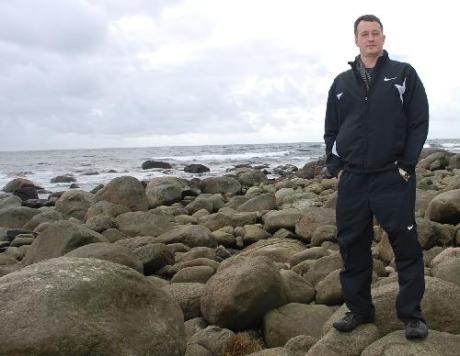
The windy and rocky south shore of Norway (photo credit: Laura Nielsen)
To see the Oil Museum and to pass through the countryside of Norway is to be reminded of the particular form that industrialization took in Scandinavia in general and Norway in particular. As the oil drilling rigs are interspersed among the rough seas of the north Atlantic, the occasional industrial concerns on land are interspersed throughout the largely unchanged landscape of Norway. Life is and can be completely transformed by industrialization, as we have observed in this forum on many occasions, and this transformation of life often brings a transformation of the landscape… but not always.

Preternatural beauty along the south coast of Norway (photo credit: Laura Nielsen)
In Norway one sees the interpenetration of the traditional and the industrial. The ways of life represented by the traditional and the industrial are here not mutually exclusive, but continuous. Many people have a traditional family farm, or a cabin in the mountains or along the fjord, while also having their work in the industrial sector of the contemporary Norwegian economy. Here, industrialization appears — at its best — as an extension of life, as an improvement in the quality of life coupled with greatly expanded opportunities, rather than a transformation of life that involves the replacement of one way of life entire with another.
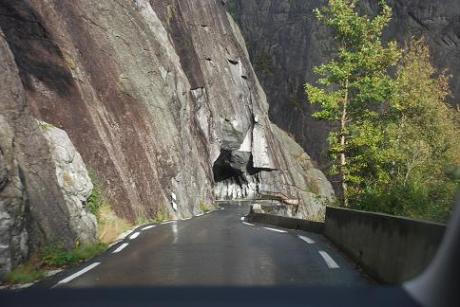
It takes patience to drive in Norway: narrow, winding roads cannot be rushed, nor can waiting for the ferry. Roads so narrow that only one vehicle can pass at a time are common in Norway. (photo credit: Laura Nielsen)
The kind of industrialization experienced by Norway is less likely to produce alienated labor on a large scale, but with the relatively small scale of the Norwegian population there is little that happens here on a mass scale. Nevertheless, there are lessons to be learned here. In pre-industrialized societies, while no everyone would ideally wish to be a subsistence farmer, almost everyone ends up doing so because there are few other options. In industrialized society the options for employment are greatly expanded, and if this expansion can open opportunities for individuals without creating the conditions for mass discontent, this is all to the good.
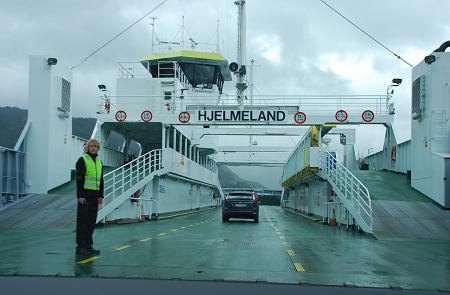
Norway has a thriving industrial sector that does not dominate the landscape, but finds a place within the landscape. (photo credit: Laura Nielsen)
Different forms of industrialization are conducive to different forms of labor. The mass labor of the factory system is an undifferentiated as the inevitability of subsistence farming among pre-industrialized peoples. But not all industrialization takes this form. Consider, for example, the industrialization of the fishing industry, which has long been central to the Norwegian economy. In its early stages, the industrialization of fishing is likely to increase yields, to reduce the difficulty and danger of the fisherman’s labor, and (again, initially) does not create mass unemployment through automation. (Perhaps the experience of the industrialization of the timber industry in Finland is a similar case, although I am just speculating here.) The later stages of industrialization have changed many of these initial effects, but the time allowed for transition can be crucially important.

Helicopter technology is particularly well-suited to the Norwegian landscape and they play a crucial role in servicing oil platforms and even in building cabins in the mountains.
In so far as experiences of industrialization go, it is difficult not to see that of Norway as anything other than the optimal path of industrialization. Whether or not this continuity of tradition with industrialization could be accomplished any other place in the world remains an open question.
. . . . .
The Undocumented Migrant Agricultural Labor Experience
11 September 2009
Friday

Harvesting plums
It is fall and harvest time in the northern hemisphere — a time for “wintering in” — and the more northerly one finds oneself in the northern hemisphere, the earlier that fall comes. In Norway, fall comes early indeed, and in the fjord country of western Norway a cooler and wetter fall follows a cool and wet summer. But when the sun comes out, it still feels warm, and we had a beautiful fall day in Sand i Ryfylke.

Harvesting plums (photo credit: Laura Nielsen)
The apples and the plums were ready to harvest at my aunt’s house, so my sister and I filled container after container with plums, and filled a wheelbarrow with apples. Norway is not known for its agricultural produce, but what fruit is grown in Norway during the very short growing season can be very sweet. The length of Eidfjord, immediately north of here, is filled with cherry trees, and this makes for a beautiful drive in the spring when they are in bloom, or makes for plentiful cherries available at roadside stands later in the summer. The best strawberries I have ever had in my life were small and sweet berries from my aunt’s garden right here in Sand i Ryfylke.
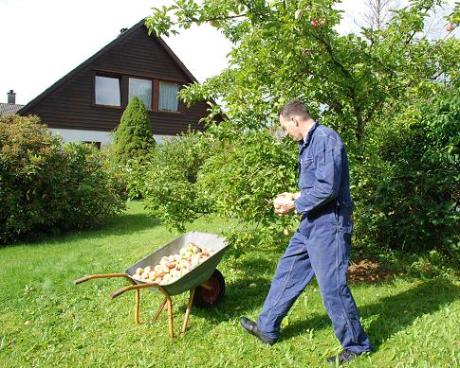
Harvesting apples (photo credit: Laura Nielsen)
It is fascinating to see agriculture in the fjord country, which is confined to a small strip of land between the waters of the fjord and the steep rock wall behind. It is an unforgiving land to farm, no doubt, but farm it the Norwegians do, and it is one of the pleasures of driving along the fjord to look across at the opposite side and see the farms extending from the water’s edge, cultivating every available inch of soil, right up to the rocky walls of the fjord.

Apples! (photo credit: Laura Nielsen)
There is a palpable satisfaction in work that provides a visible result of one’s labor. This is a satisfaction largely absent in industrialized society, and this is probably much more of a problem than is generally realized. Much of the anomie and alienation of industrialized society is the result of what Marxists call alienated labor. It is also said that the agricultural proletariat is among the most miserable of creatures, and there is that famous quote from Marx about the idiocy of rural life, yet the harvesting of food not only provides the satisfaction of a visible result of one’s labors, but one also has the satisfaction of eating as a result of one’s labor — an essential form of satisfaction and a conditio sine qua non of continued existence.

Is weeding agricultural labor? It certainly falls within the category of work usually performed by undocumented aliens. (photo credit: Laura Nielsen)
What would constitute non-alienated labor? Part of the relative “success” of the term “alienated labor” is its immediate intuitive appeal. A well-chosen word or phrase can go a long way toward explaining the success of an idea or a theory. “Alienated labor” is such a well-chosen phrase. It is difficult to even conceive of its opposite — what would we call it? Integrated labor? The labor of self-efficacy? Labor integral with life? All are awkward circumlocutions. Marx contrasts the alienated labor of the factory system of production with the guild system, but this is another of Marx’s historical fantasies tinged with hypocritical nostalgia (as with the “feudal, patriarchal, idyllic” production relations discussed in Globalization and Marxism). The guild system was as abusive as the factory system, if not more so. No amount of sentimentalism can change this.

Evening in fjord Norway: Sand i Ryfylke (photo credit: Laura Nielsen)
Of course, what is all important is how one goes about obtaining a rewarding experience of harvesting one’s own food. If one is in fear of starvation, there would be little pleasure and much anxiety in the process. From the comfortable perspective of industrialized society with its plentiful food it can be a pleasant hobby to engage in some backyard farming for the pleasure of watching one’s vegetables grow and enjoying the novelty of eating one’s own produce. Food production thus becomes an option, even a luxury, rather than a necessity. Which just goes to show you how industrialized society radically reversed patterns of human activity going back to the Neolithic agricultural revolution. Hunting, too, has become an option or a luxury, thus overturning an even older pattern of human existence. Nothing, even the most elemental experiences of life, have been left untouched by the Industrial Revolution.
. . . . .
The Charms of Small Town Norway
10 September 2009
Thursday

(photo credit: Laura Nielsen)
As I am, at present, enjoying the charms of small town Norway, and am staying with my aunt in Sand i Ryfylke, I cannot post anything of significance here for the time being. I am using a computer at the Kulturhuset i Suldal, and the Norwegian keyboard is slowing me down considerably. Last year when I was here I asked if there were any wireless networks in Sand, and the librarian at the Kulturhuset told me that there were not any. Nothing much seems to have changed since last year. And this is as it should be.

Wittgenstein spent a considerable period of his early working life in the tiny town of Skjolden at the end of Sognefjord (one may recall his early “Notes Dictated to G. E. Moore in Norway,” which belongs to the formative period of the Tractatus), seeking the kind of philosophical isolation that Descartes found in Holland.

Wittgenstein remained in contact with his acquaintances in Norway while he was not in the country, and these letters have been published. Many of the letters to Wittgenstein from residents of Skjolden end with a closing (the extact wording of which I cannot recall) to the effect that things here (i.e., in Skjolden) are as they were before. I discussed this with my mother once, and she said that she had received many letters from the old country (in this case, Sweden) to the same effect. One could call this an appreciation of the perennial, and it is the perennial that one experiences in coming to know the charms of small town Norway.

Downtown Sand (photo credit: Laura Nielsen)
A couple of years ago in 2007 I drove up Sognefjord as far as Urnes, to see the Stave church there. Skjolden is just one more fjord up from Urnes, and though I wanted to see it for its connection to Wittgenstein, I didn’t have the time. Perhaps some other year.
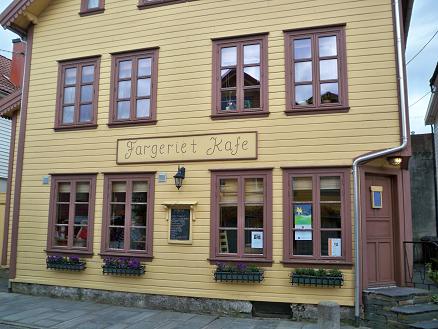
Thursday is Komle day at the Fargariet Kafe in Sand, so we have all just returned from a great meal, and there are sun breaks in the mostly overcast September skies.

Thursday is komle dag. (photo credit: Laura Nielsen)
. . . . .
Since the above was written a neighbor has given me access to their personal wireless network. Thanks!
. . . . .
. . . . .
Viking Civilization
6 September 2009
Sunday

Several times in this forum I have mentioned Kenneth Clark’s documentary Civilisation: A Personal View. I have a great admiration for his engagement with important ideas, and his willingness to be bluntly honest about this personal views, to admit his prejudices, and to simply say what he thinks. It is easy to get people to say what they think, but most opinions are not informed opinions. Recently on the Foundations of Mathematics listserv Allen Hazen wrote: “Moral, if there is one, is that intuitions have to be well-schooled. When one has studied set theory as deeply as Gödel did, or as Woodin has, one’s intuitions will start deserving respect.” Kenneth Clark has well-schooled views on civilization that deserve respect, although it is also important to point out that I disagree with a great many of his interpretations. What is valuable in an interpretation is not the selection of facts, of which any person familiar with the given area of study should know, but the way the facts are shown to hang together. Sometimes this can be challenging, as different people see the world hanging together in different ways. But it is the challenge that inspires us to think for ourselves.

Of the episodes in Clark’s documentary, my favorite is the first. In fact, I brought the DVD with me to Norway and re-watched part of it last night. The first episode is pregnant with much that deserves to be unfolded in detail, and it is here that Clark presents his most general, overarching theses on civilization, with which many I disagree. Clark begins his entire series by invoking the Vikings, employing the image of the prow of a Viking ship floating along the Seine, striking fear into the hearts of medieval Parisians. He returns to this image several times, and indeed later in the same episode stood in the same Vikingskipshuset that I visited today to showcase the marvelous Oseberg and Gokstad ships.

For Clark, the Vikings represent what is not civilization, and perhaps even the antithesis of civilization. I think it is fair to characterize his views in this way as he quite explicitly invokes the Vikings in order to contrast their life and their world with the life of civilization and the world of civilization. Well, we shouldn’t be surprised to hear that someone from the British Islands has a low opinion of Vikings. After all, the Vikings pillaged, plundered, looted, killed, and took as slaves his ancestors. This is not the way to win friends, though it may well influence people.

Though Clark resists giving an explicit definition of civilization, he tells us that he knows it when he sees it. He sees civilization in the edifice of Notre Dame de Paris, and apparently does not see it in the Vikings. There are several places in the first episode that Clark comes perilously close to using civilization as a evaluative term, rather than a descriptive term, not only in his treatment of the Vikings, but also in the implied (though not stated) idea that the early Christians kept the flame of civilization dimly lit throughout the Dark Ages, so the Christianity comes to be implicitly identified with civilization.

One of the properties that Clark tells us is crucial to civilization is a feeling of permanence. He extends this to the moral and psychological elements of civilization, telling as that people have to believe that civilization is worth the effort, that people must believe in what they are doing. Clark presents the Viking ship as a symbol of impermanence and fluidity, invoking the truly fluid and beautiful carvings on the prow of the Oseberg ship. For Clark, then, the Viking ship is a motif of transience, and civilization must be about permanence, not transience, therefore the Vikings were not civilized.

Does this represent the northern imagination taking shape in fear and darkness? Are battles won by sweetness and light?
Clark also says that the northern imagination takes shape in fear and darkness, and to illustrate this point he again invokes the Vikings, showing a magnificently carved animal head and contrasting this to the Apollo of the Belvedere from classical antiquity. Classical antiquity, he tells us, cultivated order, harmony, proportion, and a sense of permanence. How shall we understand Clark’s denial of Viking civilization? Firstly, Clark has an interesting and perhaps eccentric undefined definition of civilization, as later in the series he uses a Hogarth painting to explain why England at this time was not “civilized,” but I will not attempt to deal with that now. The point is that Clark’s conception is obviously subtle and nuanced, and civilization can be denied on a number of bases.

It is certainly true that the Vikings were all about mobility, and this is illustrated not only by their elegant and functional ships, but also by many of the grave goods on display in the Viking Ship Museum. There is, for example, a wonderful cooking pot that is as elegant and functional as the ships. One can see that it is designed so that the frame that holds the pot over a fire can be completely collapsed, though it easily folds out to form a stable tripod, and each leg of the tripod ends in a three-pronged talon that would bite into the ground. It would be difficult, more than a thousand years later, to design anything better. There was also a bed with beautiful dragon heads that could be completely disassembled, loaded on board a ship, and re-assembled at the next destination. What does this evidence other than a sense of order, harmony, and proportion, though it is the order, harmony, and proportion of the transient life? And what is life if not transient?
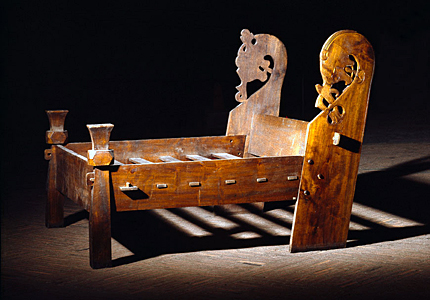
Thus Viking life and Viking technology were built around transience and predicated upon transience. They created a civilization of mobility, but a civilization nonetheless, for the Viking era produced a civilization of the mind that remains meaningful and moving today. One cannot honestly say, as Clark said of the exhausted Romans of late antiquity (echoing but not crediting Gilbert Murray’s matchless book Five Stages of Greek Religion with its famous failure of nerve thesis), that the Vikings had nothing to live for and that they saw no point in going on. On the contrary, the Vikings were deeply committed to their lives of plunder and rapine. It was, as I suggested yesterday in Art and Landscape, a way of life that naturally emerged from the geography of Norway.

We can say, as a matter of fact, that the Viking life gave way before the pressure of Christianization and the expanding medieval European economy and hence, by extension, way of life, but this is a separate historical phenomenon. Compare, for example, the nation-state system in our own time: just because every people has attempted to assimilate itself to the nation-state paradigm as the reigning political form of our time does not mean that these peoples were all intrinsically dissatisfied with a political order not based on the nation-state system. Similarly, the Vikings gave way before Christianity and medieval European kingdoms (the reigning political paradigm of that time), but that does not mean that the Vikings decided that they preferred to earn their bread by the sweat of their own brows when bread could be had for pillage.

It may well be what distinguishes the Vikings and the civilization of the mind they inhabited was their form of historical consciousness. I can imagine a Viking raider of the ninth or tenth century desiring that his transient life of raiding should go on forever. His view of history and of the world was not cyclical, as with most pre-modern peoples, and it was not strictly speaking a linear historical consciousness (though, as I have noted in From Islam to Iceland, Norse mythology is strikingly linear). Perhaps the Viking civilization of transience was predicated upon an historical consciousness of the eternal present, something such as I credited to classical antiquity and called the history of the eternal present (in From Islam to Iceland). But just as the order, harmony, and proportion of the Vikings was not that of classical antiquity, so the history of the eternal present of the Vikings was not that of classical antiquity.

Finally, about the claim that the northern imagination takes form in fear and darkness, which is connected to the claim of the frightening apparition that the Vikings would have been, with their carved animal heads and barbaric appearance: any people who live by the sword know that they can be more successful if they achieve shock and awe. Warlike peoples often knowingly cultivate a fearsome appearance, and this can go to the extent of living a known known by repute to be fearsome. In other words, the frightening Viking art may have been intentionally frightening. The Viking mind was not about fear; the Vikings played to the fear and the darkness in the minds of their victims.
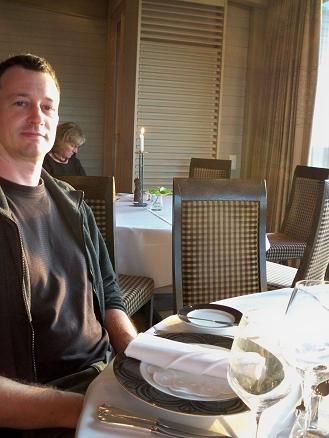
I finished the day with a marvelous dinner at Lysebu in the hills up behind Oslo.
. . . . .
. . . . .
Art and Landscape
5 September 2009
Saturday

One of the earliest posts I wrote for this forum was Life and Landscape, in which I attempted to lay out my point of view on the integral character of the life of a people and the geographical conditions of life imposed on a people. This is a theme that has been central to my thinking about economic, social, and political institutions. In short, geography and climate shape the life of a people: the kinds of agriculture that are possible, the plants that will grow, the animals that live in the region, and so forth. From cultivation of food within a given landscape there emerges a traditional form of life for those who live in the landscape. From the traditional form of life there emerge local economic, social, and political institutions. From the interplay of life and the institutions emergent from life, there emerges the entire realm of intellectual activity, so that even our ideas are derived from soil, albeit at a certain remove. Today when I was at the National Gallery in Oslo I was struck by the applicability of this thesis to art. Fine art represents the highest reach of human intellectual activity, but it reveals its connection to the landscape from which it emerges in a concrete way.
Most who come to the National Gallery in Oslo come to see Munch’s “The Scream” which is the most famous work here. It is in a room filled with masterpieces by Munch, and one is liable to be overwhelmed by this and take little notice of the rest of the collection, though the museum has a full complement of European art. Of Munch’s contemporaries, elder and younger, there are works by Manet, Monet, Renoir, Rodin, Degas, Braque, Matisse, Picasso, Cézanne, Gauguin, and even van Gogh. There is also a room with the Langaard Collection that includes an El Greco and several Dutch paintings of the Golden Age.
The works from the south of Europe look utterly out of place here to me. Even the works from Holland seem out of place, but this certainly makes sense as the Dutch landscape is the antithesis of the Norwegian landscape. And it is not only the art works that come from elsewhere that seem out of place, but also the styles that have been imported. Styles, like populations and ideas, migrate; they become internationalized and experience adaptive radiation. The more modification a style experiences with its descent, the more it can accommodate itself to the local landscape. But other factors intervene. The easier life in other climates has led to a disproportionately large population in these regions, so that styles and ideas tend to emerge here first and later move with migrating peoples to other climates, often displacing native styles and ideas from less populated regions.
When we see a painting that looks more like Poussin than Poussin himself, or when we see a repetition of the aesthetic convention of small figures lost in a vast landscape, art has here become so subordinated to style that it is the style rather than the content that is being represented. Oluf Wold-Torne’s “Landscape from Holmsbu” (1911) has been so transformed by southern impressionism influenced by Cézanne and Gauguin that he makes the fjords of Norway pass reasonably well for the low hills of Provence. But, as Tertullian once asked what Athens has to do with Jerusalem, we can ask, “What has Provence to do with Norway?”
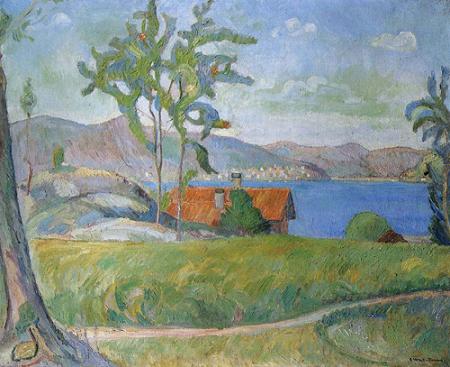
Oluf Wold-Torne, Landscape from Holmsbu, 1911
Jean Heiberg (1884-1976) was influenced by Matisse, studying under the master in Paris, but he represents a greater degree of adaptation of the southern style to the northern climate. His painting of a boy is an acclimatization of Impressionism and thus a more successful rendering of its subject, which is here less style itself than life itself.
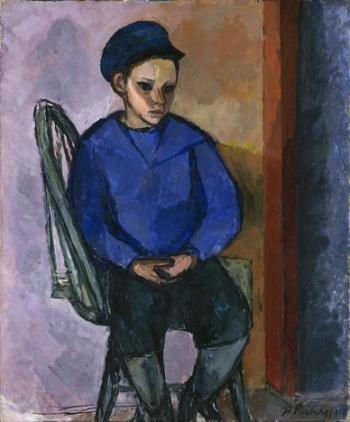
Jean Heiberg
Norway has a unique landscape, and a unique culture has emerged from this landscape. In earlier times, the deep interpenetration of the land by the fjords, difficulty of travel by land, easy access to the sea, and the difficulty of farming led to a social structure ship-borne raiders who pillaged and plundered around Europe. The Vikings took advantage of a unique historical opportunity — the devolution of authority to the local level following the collapse of Roman power in the West — to prey upon isolated coastal communities. The power structure of Viking society was remarkably egalitarian, though certain leaders emerged at times. But anyone could learn ship building in Norway and find an isolated spot along a fjord to build a longship. While the spot would be difficult for others to find, it was relatively easy for an experienced sailor to strike hundreds of miles from his home base, and return within days. Thus slaves and plunder were brought back at a relatively low cost.
Political unification under Harald the Fairhair and Christianization ended the Viking age, although the pagan “hard cases” who didn’t want to live under this regime left for Iceland, and they created a unique literature: Skaldic poetry, Eddas, and sagas. Thus Viking civilization underwent its own adaptive radiation, though its colonization of Iceland displaced little in the way of local native culture as Iceland was virtually empty at this time, save for a few Irish monks.
Back in Norway, political unification and Christianization opened Norway to the civilization of Christendom, and this cultural juggernaut emergent from the intense competition of high density populations largely displaced Viking culture — but not entirely. Also, another kind of uniquely Norwegian culture emerged from the need to create a local agriculture to sustain a population that no longer raided other peoples with impunity. Still today one sees the barns built into the hillsides of the fjords, with sod roofs and a ramp from the hill side of the barn leading into the second story of the structure. Domestic animals were kept inside during almost the entire winter, and this required careful planning and storage in order to feed both family and animals during the long winter.
The culture from which Munch came had these traditions that emerged from the unique landscape of Norway, though overlain with cultural influences from elsewhere in Europe. As we have seen above, these imported cultural traditions, including aesthetic styles, at times wholly submerged the native traditions of the region, but those traditions and the way of life is always there, even if not represented in fine art. We cannot even say that it remains “below the surface” because it is a way life carried on quite in the open, though it is, as they say, “below the radar” of high art. What do Impressionism Fauvism, Dadaism, or any other “ism” have to do with cultivating cherry trees along the fjords of Norway? Another question: what ought they have to do with it? If an art does not express the authentic life of a people, it is not an art worth having. The styles of the south of Europe authentically express the spirit of the southern peoples, but in Scandinavia this is at very least questionable.
Munch created a personal style of art that is emphatically an art worth having. Whether its uniqueness is that of Munch himself or that of the Norwegian character I will not inquire, but it is unique, striking, memorable. It is for this reason that “The Scream” has become an international icon, and the mechanical reproduction of this image, and the repetition and variation throughout popular culture, once again represent an adaptive radiation of a style of art, but this time emerging from Norway and making its way into the wider world.
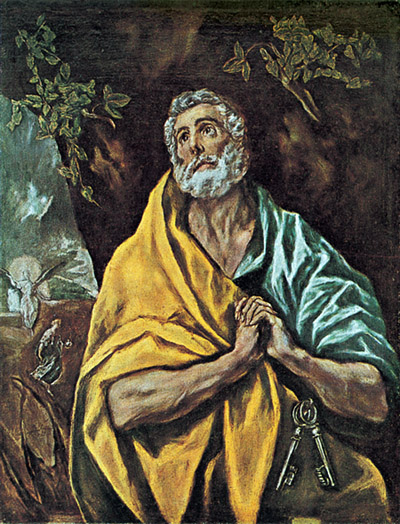
El Greco in Oslo: the inner light and inner life of the subject is made manifest.
Many are the ways in which figures, or indeed a landscape entire, can be lit from within, giving inner radiance and inner life to the subjects of a work of art. El Greco represents one very distinctive form of this, focused upon the figures in his paintings. Poussin represents another form of inner radiance and inner life, in his case focused upon the landscape itself, and we can see the influence of the sublime Poussin landscape in a large gallery near the Munch room, where hangs the famous Brudeferd i Hardanger of 1848. All the works in the room (I didn’t take the time to write them down, and didn’t buy a museum catalogue) are captivating, but in a very different way than the works of Munch.

Not Munch: Brudeferd i Hardanger of 1848 shows the inner radiance of the landscape, but there is nothing unique in its style of representation.
In Munch, men and women become spirits, or perhaps more specifically, they become ghosts, living a life, such as it is, of greatly attenuated embodiment, almost to the point of incorporeality. There is no question that the body is here subordinated to the spirit: these hollow-eyed figures seem more dead than alive, though not entirely dead, and not entirely alive. On the other hand, the ordinary objects of life are imbued with a special life and radiance of their own, raising them up from a purely or merely corporeal existence, thus placing them on essentially the same plane of beings as human beings — they are (or have become, in the world of Munch) beings in their own right, neither better nor worse than human beings, but representative of an ontological egalitarianism.

Munch, Moonlight, 1893
The picket fence and the window frame in “Moonlight” (1893) are more radiant than the face of the woman who is the only figure in the picture — or is she? She casts a green shadow that seems to have a mysterious and menacing life of its own. In Munch’s “Puberty” (hanging in the same room) the single central figure also casts an amorphous and menacingly alive shadow.

Munch, Death in the Sick-Room
In “Death in the Sick-Room” three figures have faces about the same color of green as the walls, while the other three figures whose faces appear have ruddy faces a little darker than the floor (the face of a seventh figure, weeping while seated in a chair, is not visible). In other words, the figures have been subsumed under the room in which they appear.

Munch, Self Portrait
In Munch’s self portrait of 1895 he looks like a ghost surprised by the living, and indeed surprised by the living viewer who has rudely interrupted his spiritual reverie, although it is a spiritual reverie of a curiously worldly character.

Munch, Madonna
Easily the most compelling work in the Munch room of the National Gallery is his “Madonna” with her flame-red halo. No reproduced image can do justice to this; you must go to see it with your own eyes. In fact, I had difficult taking my eyes away from it, for each time I looked away I found my eye drawn back to it. Here the single, central figure is set against a swirling background, like the swirling lines of “The Scream.” The Madonna has no arms or legs, though she in no sense appears incomplete. Her limbs are imperceptibly caught up in the whirlpool that is the world, and we scarcely notice that we do not see them. Is the Madonna fading into the background, losing herself in the world, or has she only just emerged from the world, as though the world had pushed up some profound part of itself from a deep place up into the light, but into a surreal, preternatural light that perhaps is the very light of her flame-red halo? Is she illuminated from within or from without? In the context of ontological egalitarianism, these are simply two perspectives on the same state of affairs.
. . . . .
. . . . .
Oslo, The Quiet City
4 September 2009
Friday

Newly arrived in Oslo and in Frogner Park, I still have my glasses on as I don't wear my contacts while flying.
Oslo has always impressed me as a quiet city. Even Stockholm, the capital of Sweden, which one might wrongly suppose to be similar in character, is busy and bustling in comparison. I can’t think of any other place in the world where I have encountered such urban serenity. It is almost as though “urban” and “frenetic” are synonyms, except that Oslo disproves this. Even Frogner Park, where tourists are in evidence and one can hear the babble of many languages being spoken, is overall a very quiet and peaceful place.

Aggressive birds at a cafe in Frogner Park clean the crumbs off my plate.
I went straightaway to Frogner Park. My room at the Saga Bed and Breakfast is about ten or fifteen minutes walk away, which is convenient. Tomorrow I will see how long a walk it is to get to the center of the city and the harbor front, but I don’t have the strength for that now. But I did, before crashing, find the strength to visit the Vigeland Museum and the Oslo City Museum, both of which are right in Frogner Park.

Frogner Park is a catalogue of the human condition, an encyclopedic account of human life, its stages, its moods, its hopes, and its fears. I am told that when my maternal grandmother (who was from Sweden, not Norway) first saw the central monolith here in the 1950s, she said that that it was an accurate portrayal of the way that life is, with people crawling over each other and struggling to rise in the world. This is as good an interpretation as any I have heard. It is, indeed, one of my reactions when I look at the monolith. But today I was more taken with the reliefs that surround the fountain below the monolith.

Looking at these Vigeland reliefs I was reminded of the great bronze doors at the Hildesheim, sometimes called the Hildesheim Doors (as in Gardner’s Art Through the Ages) and sometimes called the Bernward Doors (after St. Bernward, who commissioned them). The Hildesheim Doors are one of the great masterpieces of early medieval art, and indeed one of the great treasures of European art, though they are not well known. If one compares, for example, the legendary doors to the baptistery of Florence by Lorenzo Ghiberti (being similar in layout though profoundly different in conception and execution; I’ve seen both in the flesh), there are few who have not heard of them. I will assume that this is a consequence of the prejudice in favor of the South that Jonathan Meades described in his Magnetic North television program.

We know that Vigeland was influenced by medieval art, as he was involved with restoration work at Nidaros Cathedral in Trondheim, which is the most impressive cathedral in Scandinavia. (Trondheim, I might mention, is a very quiet city.) From his work at Nidaros Vigeland took away an interest in the dragon or the serpent as a symbol of sin, that is to say, untrammeled nature as expressed in human action. It is fascinating to see in the Vigeland Museum Vigeland’s several early drafts of the central monolith for Frogner Park. There are many models of diverse character, some of which show a monolith entirely composed of intertwined serpents, giving a very different impression than the present monolith.

Early models for the monolith at the Vigeland Museum.
The theme of the serpent, of the human struggle with nature, including the struggle with human nature, is expressed in several other monumental sculptures in the Vigeland Museum. In the museum one also sees several supernatural figures, angels and devils, sometimes locked in a dialectical dance, and sometimes with a human figure between them. It is striking that in the finished version of the Vigeland sculpture garden at Frogner Park we have, as I said above, a catalogue of the human condition. Save for two exceptions that I noticed (and these were stone sculptures set high on pillars and thus suspended above the arena of human activity, as it were), all of the sculptures in Frogner Park were human, all-too-human, thus making Frogner Park an essay upon man and the human condition.

Why would Vigeland have set aside his fascination with the serpent to focus upon man? Obviously, man interests us. It is, of course, the human interest, and we all know that the human interest is what captures our interest. Fantastic stories may entertain us, but we always come back to our human identity, for better or worse. Thus Vigeland has populated Frogner Park with a human population that is very much like the population that comes to visit the park.

Indeed, the two populations — the transient population of visitors and the permanent population of archetypes — live separate yet parallel lives, intersecting in Frogner Park, crossing paths as one population walks among the other. And I would guess that just about any visitor to the park can find himself mirrored in the parallel population of permanent residents. Look among the many faces and the bodies writhing and pain and joy, and somewhere in the welter of experience your own life will be reflected to some reasonable degree of accuracy. Vigeland proved himself to be a great artist of Shakespearean scope in his ability to capture the diversity of the human condition.
. . . . .

. . . . .
. . . . .






